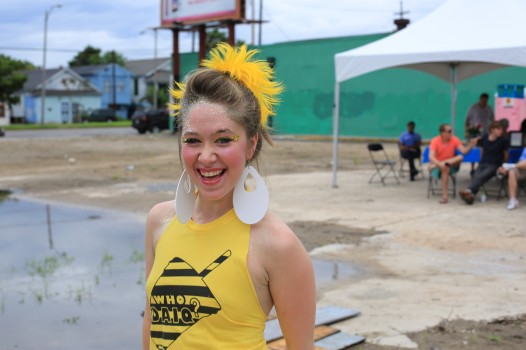Editor’s Note: OK, here at NolaVie we missed it. National Daiquiri Day. Which was Friday, July 19. (While we’re confessing, we might mention that we also neglected National Hug Day back in February and National FourSquare Day in April.) At any rate, the folks over at the New Orleans Daiquiri Festival used the occasion to announce the official opening of Daiquiri Season, which we intend not to ignore so ignominiously. To that end, we offer a reprise of Anna Shults’s ode to New Orleans daiquiris, first published in August 2012. Oh, and the 3rd annual New Orleans Daiquiri Festival will take place Saturday, Aug. 17, at Michalopoulous Studios, 527 Elysian Fields.
New Orleans is known for drinking, period, but it is also known for specific cocktails. Sweet, cold, anything to ease the pain of living somewhere with sauna like conditions for a third of the year. Forget the Hurricane, the Pimm’s cup, the hand grenade, even the Sazerac. The daiquiri is as quintessential as Nola liquid love comes. The perfect drink for all occasions, including no occasion at all, reaches from Bourbon Street to the Bywater to the drive-thrus in Metairie (just don’t put the straw in).
However, the daiquiri as we know it today is a far cry from its predecessors. The original daiquiris were made in Santiago, Cuba, in the 1890s by Jennings Cox, and made simply with cracked ice, sugar, lime juice, and rum—stirred, not shaken. By the early 20th century, the daiquiri had migrated to Havana and evolved into a shaken, strained cocktail similar to a rum sour. The frozen daiquiri as we know it today was invented in the early 1930s by Constantino Ribalaigua Vert, the bartender at Bar la Florida. Due to Prohibition, Cuba was a popular destination, filled with American tourists. Bar la Florida, also known as Floridita or “Little Florida,” was a popular bar, and the blender could not be heard over the noise. The frappe-style drink was perfect for the steamy climate and allowed the bartenders to make a high volume of drinks at once.
The bar and drink were favorites of Ernest Hemingway and John F. Kennedy. The drink is described in Hemingway’s Islands in the Stream as, “so well beaten as it is, [it] looks like the sea where the wave falls away from the bow of a ship when she is doing thirty knots.” It was, however, first mentioned in literature by F. Scott Fitzgerald in This Side of Paradise, in which the character asks for a double daiquiri, but wait, make it four (a common mistake most of us have made, I’m sure).
The classic daiquiri remained popular in the United States through the 1960s. In the 1970s, there was a sort of daiquiri paradigm shift, moving away from the strained, tart, and sophisticated to the frozen, sweet, and large. Nowadays, daiquiris describe a style of drink more than a set of ingredients. Rum is no longer a requirement. Though these are not daiquiris by the traditional definition, that is the drink’s most recent evolution. Though frozen daiquiris used to be seen as the death of the craft cocktail, the blender is making a comeback. As New Orleans becomes more of a world-class cocktail city, it’s natural the daiquiri would receive some much-deserved attention.
Though New Orleans is famous for dozens of drinks, the daiquiri holds a special place because it is so unique. It is not served in many bars, and many of the shops that do serve it offer nothing else. It is not a drink made for sitting inside, but rather, for taking by gallon or go cup to Mardi Gras parades, second lines, or just walking the dog in City Park. Open container laws are a huge part of what makes daiquiris successful in New Orleans. They are sweet enough to feel festive and decadent, yet cheap enough that they are for all occasions, not just special ones.
 Jeremy Thompson of the Open House New Orleans Company (OH NO Co.) celebrated the history and culture of the daiquiri on Saturday. With lines stretching across the lot, thirsty patrons braved the light rain and hair-curling humidity to get hand-shaken and frozen daiquiris. With DJs, daiq swag, coozies, the Who Daiq Flava Girls, and a food truck, the daiquiri enjoyed a celebration fitting of its iconic status. Instead of celebrating with daiquiris, which we’re all used to, we celebrated the drink itself, with a catchphrase inspired by one everyone in New Orleans should be familiar with: Who daiq?
Jeremy Thompson of the Open House New Orleans Company (OH NO Co.) celebrated the history and culture of the daiquiri on Saturday. With lines stretching across the lot, thirsty patrons braved the light rain and hair-curling humidity to get hand-shaken and frozen daiquiris. With DJs, daiq swag, coozies, the Who Daiq Flava Girls, and a food truck, the daiquiri enjoyed a celebration fitting of its iconic status. Instead of celebrating with daiquiris, which we’re all used to, we celebrated the drink itself, with a catchphrase inspired by one everyone in New Orleans should be familiar with: Who daiq?
And for the record: the hangover was totally worth it.
Anna Shults is associate editor for NolaVie.
 NOLAbeings
Multimedia artist Claire Bangser created NOLAbeings as a portrait-based story project that marries...
NOLAbeings
Multimedia artist Claire Bangser created NOLAbeings as a portrait-based story project that marries...
 Data corner: Adobe Suite (create a PDF, social media graphic, presentation, edit a photo and video
Data corner is where you go to work with analytics and top tech skills. It takes on everything from PERL and SQL to Canva and Sprout Social.
Data corner: Adobe Suite (create a PDF, social media graphic, presentation, edit a photo and video
Data corner is where you go to work with analytics and top tech skills. It takes on everything from PERL and SQL to Canva and Sprout Social.
